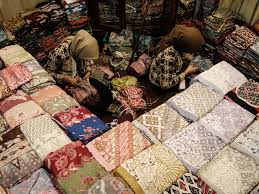Indonesian batik, a revered art form with roots stretching back centuries, is more than just a method of fabric decoration. It embodies a cultural philosophy, with each design telling a story of its origins and purpose. As the batik capital of Indonesia, the city of Solo in Central Java stands at the forefront of this rich tradition, where artisans like Gunawan Setiawan, a fourth-generation batik maker, continue to practice and preserve this unique craft.
The Essence of Batik
At its core, batik is a technique that uses wax and dye to create intricate patterns on fabric. Setiawan explains that the process evolved from ancient times when people began decorating the cloth they wrapped around themselves. While similar techniques exist in other countries, Indonesian batik has developed its own distinct characteristics and cultural significance.
The colors and motifs of batik vary across Indonesia, reflecting the diverse environments and cultures of the archipelago. In Solo, the palette is dominated by calm earth tones – browns, beiges, and golds – mirroring the surrounding landscape of trees and leaves. Coastal regions might favor blues and greens, while areas near volcanoes incorporate reds and oranges into their designs.
Cultural Significance and Challenges
Indonesian batik is deeply woven into the fabric of society, with specific designs created for various life events and occasions. From pregnancy and childbirth to weddings and funerals, each batik pattern carries a unique meaning and purpose. This cultural significance sets Indonesian batik apart from mere decorative textiles.
However, the batik industry faces numerous challenges in the modern era. Imported textiles often undercut local products on price, while younger generations may lack interest in continuing family businesses due to the labor-intensive nature of batik production. Alpha Febela Priyatmono, a batik expert in Solo, emphasizes the need to educate the public about true batik and its value beyond mere economics.
Preserving Tradition, Embracing Innovation
To address these challenges, artisans and experts are implementing various strategies to keep batik relevant and appealing. Priyatmono has developed educational programs that introduce simplified motifs to young people, making the art form more accessible. Additionally, there are initiatives to create environmentally friendly batik using natural dyes and sustainable materials, appealing to eco-conscious consumers.
The government also plays a role in promoting Indonesian batik, both domestically and internationally. National Batik Day, celebrated annually on October 2, helps raise awareness and appreciation for the craft. Indonesian leaders often gift batik to foreign dignitaries, showcasing it as a symbol of national pride and cultural diplomacy.
Reviving Batik Centers
Solo’s Kampung Batik Laweyan, a historic batik hub operating since 1546, exemplifies the industry’s resilience. After experiencing decline in the 1970s and during the COVID-19 pandemic, the area is now seeing a resurgence. With 40 to 50 sellers currently established, there’s cautious optimism about the future of batik in this traditional center.
Setiawan’s workshops at Kampung Batik Kauman offer visitors hands-on experience in creating batik, fostering interest and appreciation for the craft among both locals and international tourists. These interactive sessions provide a deeper understanding of the skill and artistry involved in batik production.
As Indonesian batik navigates the complexities of the modern world, its cultural significance and artistic value remain undeniable. The efforts of artisans, experts, and the government to preserve and promote this unique art form are crucial for its survival and growth. By balancing tradition with innovation and educating new generations about its importance, Indonesian batik has the potential to thrive as both a cultural heritage and a contemporary art form, continuing to weave its rich philosophy into the fabric of Indonesian society.
Related News
















